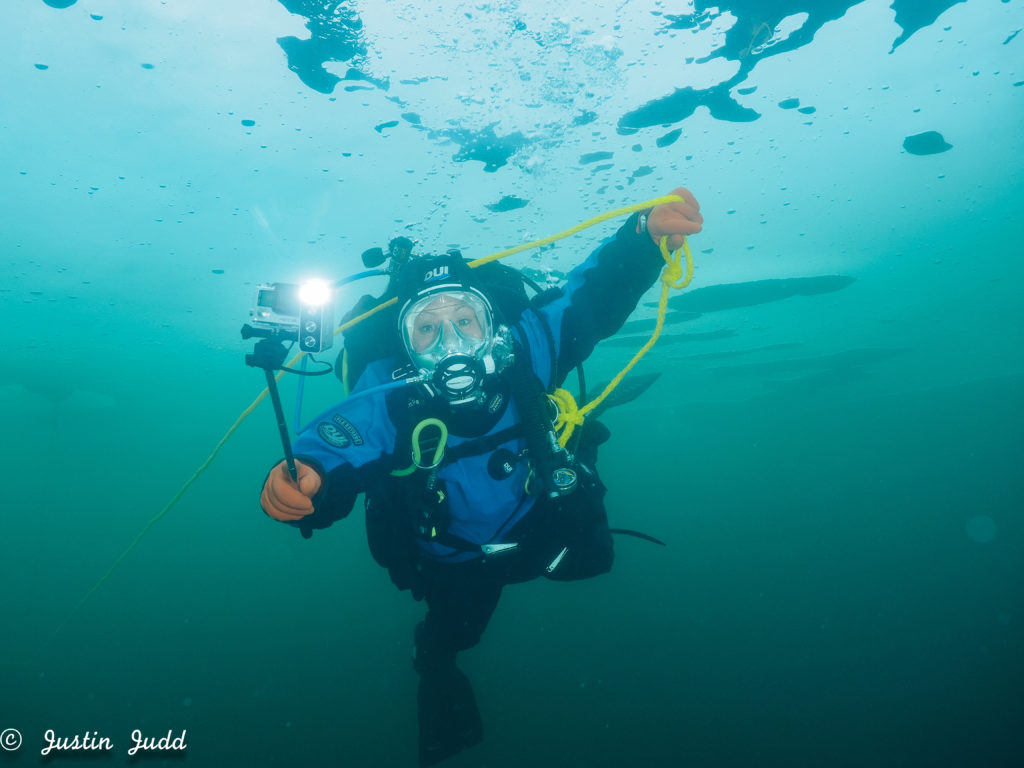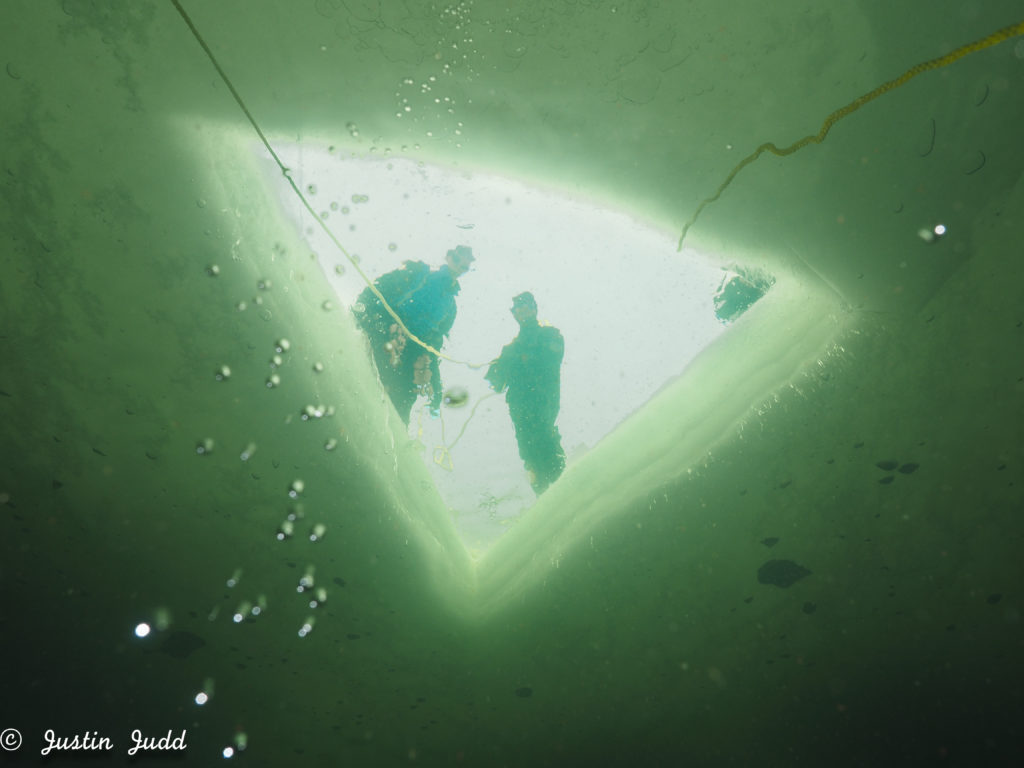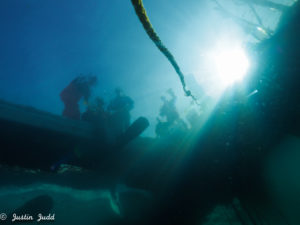The temperature outside is well below freezing and snow is falling from the sky. It’s a perfect day to go diving — ice diving, that is.
Equipped with a drysuit and several thick undergarments, you and your diving team walk out onto a frozen lake. The rumbling of a chainsaw breaks the winter silence as your buddy cuts a three-foot hole hole into the ice to reveal the black water below. Dropping in with your gear and safety line, you quickly realize how shocking 34-degree F (1 C) water truly feels. Despite the numbness in your face, you’re mesmerized by the light and texture of the under-ice environment. It’s unlike anything you’ve experienced before. If this description sounds accurate, you may already be hooked on ice diving. But for those who need some convincing, what exactly is ice diving? Where and why would you do it? Read on for the answers.

What exactly is ice diving?
Cold-water diving, not to be confused with ice diving, often involves diving in near-freezing water temperatures. For example, Silfra Fissure, a popular dive site between two continental plates in Iceland, sees water temperatures colder than 40 degrees F (1-2 C) year-round. So what, then, is the difference between cold-water diving and ice diving? Ice diving refers to diving beneath a solid or broken layer of ice that exists over a portion or the entirety of the dive site. Simplified, ice diving always involves an overhead environment and cold-water diving does not.
In order to dive safely under the ice, divers take additional precautions unique to ice diving:
- The diver is always tethered to a safety line, which a dive buddy team at the surface holds. The diver wears a specialized harness, clipped to the line so that equipment doesn’t interfere with the tether. The safety line is used not only for emergencies, but also as a communication device while under the ice.
- Each dive buddy team is increased from two to four members. Only one of the four members dives at a time; the other three play different surface support roles throughout the dive, ensuring the submerged diver’s safety.
- Dive times while using recreational scuba equipment are typically limited to less than 30 minutes. This time limit reduces exposure to freezing temperatures and provides plenty of extra air in case of an emergency.
Why try ice diving?
Why learn to dive under ice? The chance to see penguins and leopard seals underwater comes to mind, but the Arctic isn’t the only place for ice diving. Much of the Northern, and some of the Southern, Hemisphere experiences below-freezing temperatures each year, so marine and freshwater bodies could be partially or completely covered in ice and snow. When you can’t afford to travel to the tropics, why not enjoy winter diving in your own backyard?
Beside the beauty of the surface ice layer, ice diving provides unique animal experiences and dive activities that you won’t find anywhere else. Under wintertime conditions, cold-blooded aquatic animals slow their metabolisms dramatically, meaning they don’t move if they don’t have to. As long as a diver swims calmly, he or she can approach fish and invertebrates within unusually short distances. Fill up your drysuit and invert your positioning, and you can even observe those animals while standing upside-down on the surface ice.
The cold water inherent in ice diving has benefits as well. Clarity in freshwater bodies tends to increase dramatically in the winter. The lack of water circulation allows particulate matter to settle. Animals and objects you may never see in summertime are easily visible under ice. Learn to deal with near-freezing temperatures and you’ll have some of the clearest dives of your diving career.

Ice diving is a team sport
Ice-diving training not only gives you the skills to dive in extreme climates and overhead environments, it’s also a team-building exercise. Unlike most recreational diving, ice diving requires constant surface support. Don’t expect to jump in all at once — only one diver per team goes in the water. The other team members are there to support, assist in navigation and ensure diver safety.
There are four positions on each buddy team: diver, tether, bucket and safety diver. While the diver is in the water, he or she is clipped and tied to a lengthy rope. This rope is held taut on the surface by both the tether and the bucket. The tether communicates with the diver by tugging the rope, and the bucket keeps the rope slack free and organized in, well, a bucket. Safety divers are suited up and ready to retrieve the diver in the case of an emergency. In any ice-diving training course, you will learn how to play each role with confidence.
How do I know if I’m ready to ice dive?
Harsh frozen environments and the risk associated with diving underneath an icy shelf mean ice diving is not for everyone. However, the unique buddy system and heightened safety measures allow recreational divers to ice dive without any technical training. While there aren’t many diving outfits that offer “try ice diving” experiences, the specialty certification courses offered by PADI and NAUI are both affordable introductions to ice diving. After six short training dives, you’ll become a certified ice diver.
To cover the ice-diving course prerequisites, you should have over 100 logged dives, some drysuit experience, and at least an Advanced Open Water certification level. Because most frozen lakes are at altitude, be familiar with altitude-diving considerations as well. Achieving your drysuit, altitude, and ice-diver certifications at the same time is not unheard of, but we don’t recommend it.

What gear do you need for ice diving?
Though most modern dive gear will perform adequately in ice water, you must consider two items: your regulator and your exposure suit.
Many regulators are designed to function well in water warmer than 41 F (5 C). As water approaches the freezing point, however, forming ice crystals can become dangerous for your regulator’s internal parts. Purges can freeze open and first stages can go into a runaway free-flow. To prevent these problems, manufacturers install chambers in first stages that contain non-freezing liquids. These allow your first stage to operate smoothly in very cold water. Nearly every manufacturer sells environmentally sealed or cold-water regulators.
As for staying warm, a good drysuit is a must. Any type of drysuit material will work for ice diving — the undergarments are the key. Some manufacturers make thick, custom undergarments that work well for ice diving, but these are typically expensive. If you already have winter gear, you can use that, provided you can fit it under your drysuit. Puffy down coats and vests work great, as do wool layers. Wear several pairs of thick hiking socks at once — you won’t regret it.
A few accessories to consider:
- Dry gloves are a great addition to your exposure suit, especially for ice diving. However, neoprene gloves will work fine if you don’t have a dry option.
- A form-fitting dry hood will keep your neck and head more comfortable than a typical tuck-in style neoprene hood. Make sure whichever hood you choose does not interfere with your dry seals.
- Full-face masks can eliminate skin exposure to the ice water. However, simplicity is key when learning new dive skills. You may find that numb cheeks are more comfortable than dealing with a full-face mask while training.
Ice diving for photographers
Advancing their training and pushing themselves out of their comfort zones are enough reasons for many to try ice diving. Photographers and videographers have an entirely different incentive: cathedral lighting.
The only light that penetrates the snow-covered ice comes from holes, cracks and clear lines on the ice surface, much like a cave or cavern. Light hits animals, divers and other subjects in a heavenly way. Combined with the water’s clarity, a frozen lake or coastline turns into a one-of-a-kind studio set.
Here are some tips for photographers who are considering bringing gear below the ice:
- Finish your ice-training dives before bringing the camera. With so many new techniques and new gear to focus on already, bringing a camera too soon is not safe.
- Consider the effects of low temperatures on your gear. Lithium batteries run empty much faster if they are cold. Always start with a fresh battery. Also, your lens ports may fog — the temperature difference between a warm car and ice water is considerable. Use moisture control packets and keep your housing out of direct sunlight.
- Dry your housing after your dive. When water forms ice, it expands. This can crack glass components and prevent knobs or levers from operating.
- Plan communication methods with your team prior to jumping in the water. Because you are always on a safety line while ice diving, you may need to alter your communication methods. Your buddy may unknowingly jerk your arm while you’re getting your best shot yet. However, you still need to be safe, so balance your safety signals with your desire to shoot.

